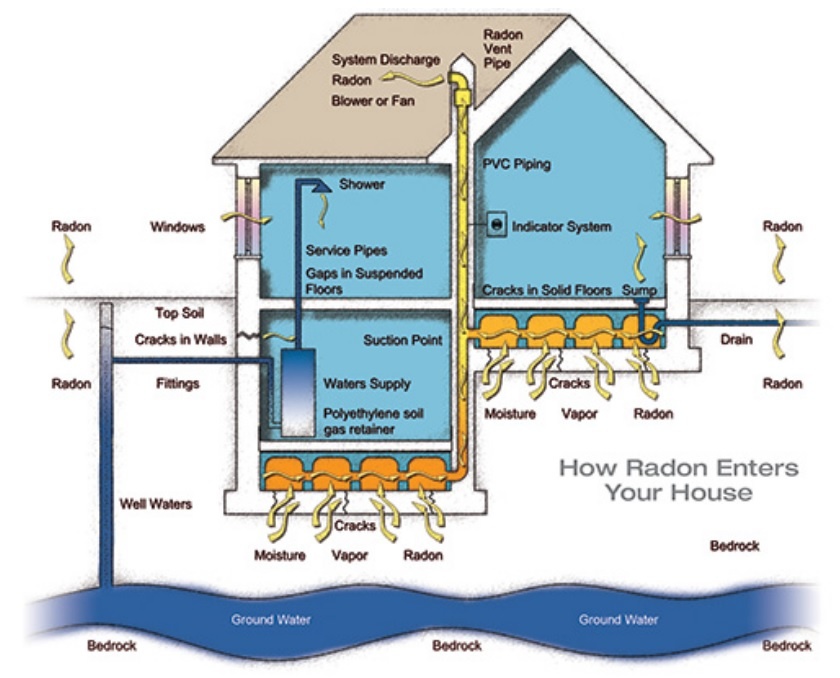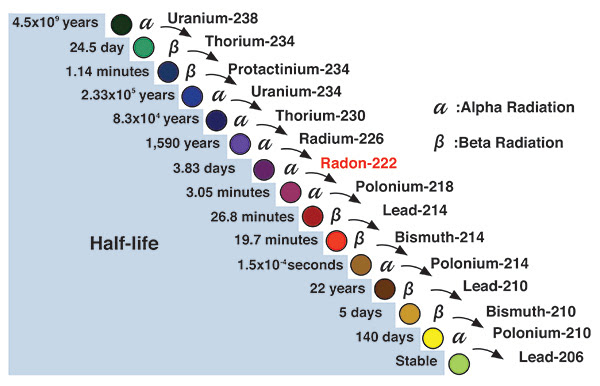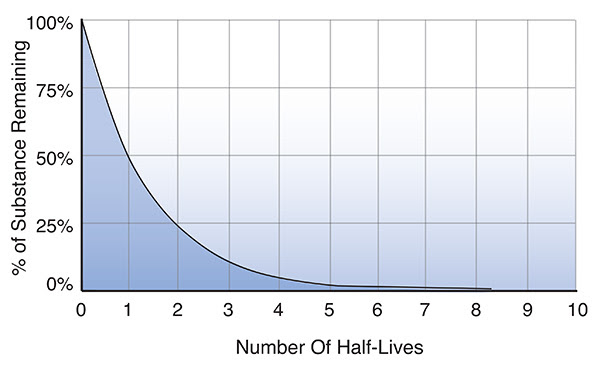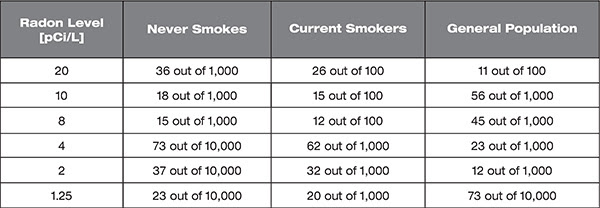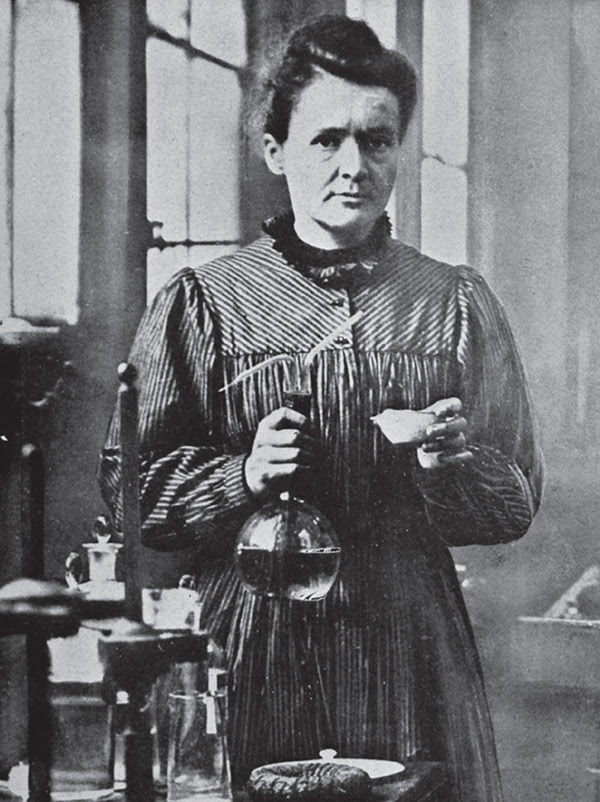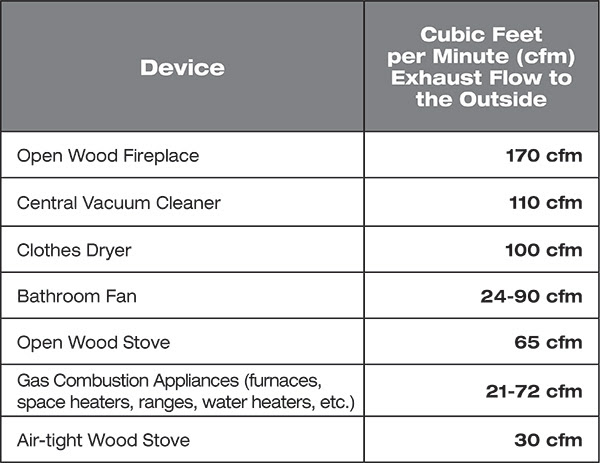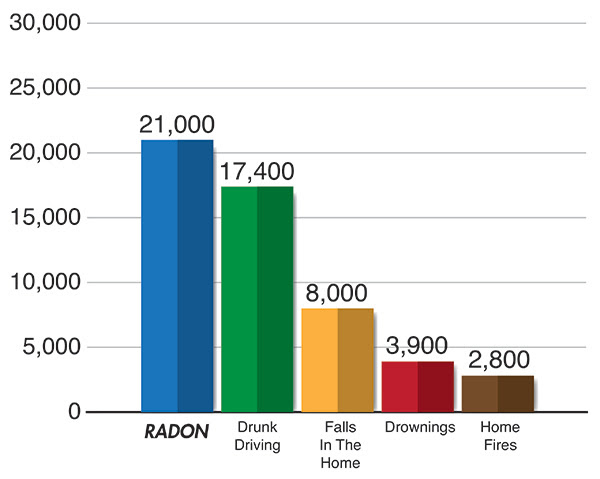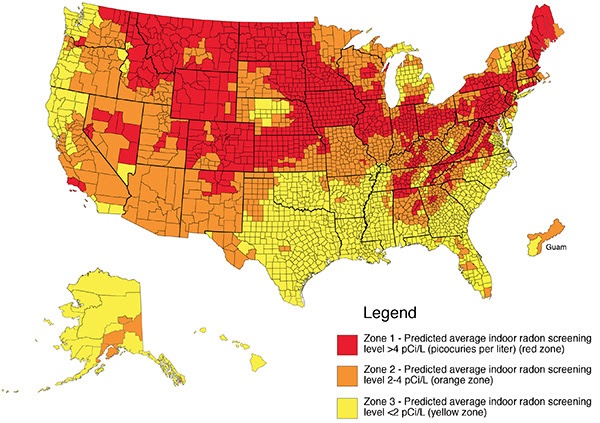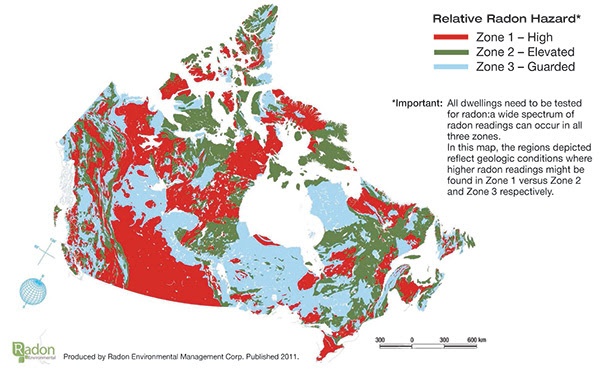Radon in the Home
Radon in the Home
By James E. Houck
Radon entering homes from the breakdown of naturally occurring uranium in soil and rocks is the second leading cause of lung cancer after smoking in the United States. According to the U.S. EPA, 15% of homes have unsafe radon levels. Without special monitors radon is undetectable. Concern over and mitigation of radon exposure impacts the hearth industry both directly and indirectly.
The primary mechanism for exposure to radon is the migration of radon gas from the soil beneath the residence and it subsequently being trapped in the living area of the home. A small amount of radon can also enter the home from rocks used in construction, other mineral-based building materials, outdoor air, and piped-in water, however, radon from soil degassing is overwhelmingly the largest source of indoor radon.
The hearth industry needs to take notice as the design of new housing and the modification of existing housing to mitigate exposure in radon rich areas can influence the type of hearth products as well as other related energy products that are installed. Also significant are the facts that making older houses more energy efficient and making them more airtight, as well as the vacuum (negative pressure) that some heating equipment and indoor exhaust fans produce, can exacerbate indoor radon levels.
Sources of Radon
Radiochemistry 101
Uranium 238 has a long half-life, i.e., it lasts a long time before it all decays away by emitting radiation. To be exact, its half-life is 4.5 billion years. A half-life is the time it takes for one half the number of atoms to decay, producing radiation in the process. For example, suppose there are 200 atoms of a hypothetical isotope with a half-life of 100 years. After one half-life (100 years) there will be 100 atoms left, after another 100 years there will be 50 atoms left, and after another 100 years there will be 25 atoms left, etc., etc.
Uranium 238, because it has been around since the formation of the earth, has had time through complex geochemical processes to be enriched in the earth’s crust. As it decays it produces a chain of daughter products, one of which is radon. Radon has a short half-life (3.83 days) and as it decays it produces more radioactive daughter products with short half-lives.
Radon is an inert gas, hence it readily migrates through soil pores and building structures and is inhaled by home occupants. Radon and two of its short-lived daughter products decay by emitting alpha (a) particles. An alpha particle among radiation types is like a bulldozer in a forest, it does not go very far because it is doing a lot of damage quickly, e.g., destroying living tissue and damaging DNA, hence the increase in lung cancer when it is inhaled.
Radon and Health
Succinctly, radon is important radiologically because, as an inert gas, it transports part of the uranium 238 decay series into the air that we can breathe. The short-lived decay products of radon 222, which are polonium 218, lead 214, bismuth 214, and polonium 214, are chemically active elements so they can deposit in the lung when inhaled. Their half-lives are so short that they are likely to decay through to the longer-lived lead 210 (half-life of 22 years) before the lung can clear them, hence the alpha decays of polonium 218 and polonium 214 give the epithelial layer of the bronchi a substantial radiation dose causing elevated lung cancer rates. Because of the chemical reactivity of the daughter products, ironically they are more health injurious than radon itself. Smoking exacerbates the risk of lung cancer from radon exposure. The U.S. EPA’s action level for radon in homes is 4 picoCuries per liter of air (4 pCi/L).For comparison, the average radon level of outdoor air is about 10 times lower at 0.4 pCi/L.
The uranium 238 decay chain. Radon 222 and two of its short-lived daughter products, polonium 218 and polonium 214, decay by emitting highly health-injurious alpha (α) particles. The beta (β) particles from lead 214 and bismuth 214 also contribute to the health impact of inhaling radon gas.
Decay of a Radioactive Substance
The shorter the half-life of a radioactive substance, a.k.a. an isotope, the more radioactive it is since the more rapidly it decays by emitting radiation the quicker it is changed into a daughter isotope. Radon 222 has a half-life of 3.83 days. Its daughter products (isotopes) of polonium 218 and polonium 214 have half-lives of 3.05 minutes and 0.00015 seconds, respectively. The half-lives of all three isotopes are short enough to be considered highly radioactive.
Air Pressure Differentials
Air pressure differentials caused by (1) the stack effect of a building, (2) various exhaust fans, and (3) heating equipment can all cause a slight vacuum in a home which has the consequence of sucking radon from the soil beneath the structure. The stack effect is caused when air is warmer in the home than outside air. The warm air rises and exits through the upper portion of the structure. This air is replaced in part by soil gases including radon.
Tall, open chimneys in multi-story homes as well as simply multi-story homes with “leaky” upper stories have the largest potential problems with the stack effect. Kitchen and bathroom fans can create a small vacuum within the home especially for “tight” homes. Similarly traditional cordwood fireplaces and B-vent gas fireplaces that exhaust through the chimney with makeup air drawn from the home can increase the amount of soil gases that enter it.
Related to the formation of vacuum within the home is the common practice of increasing the energy efficiency of older homes by making them tighter, which can have the negative consequence of increasing radon levels by facilitating the formation of a vacuum within the home and by reducing air exchange rates with outside air.
Lifetime Risk of Lung Cancer Death
(Per Person) from Radon Exposure in Homes
The unit to express radon levels in the U.S. is generally picoCuries/liter (pCi/L). Internationally, in the metric system, the unit to express radon levels such as used in Canada is Becquerels/cubic meter (Bq/m3). The U.S. EPA’s action level of 4 pCi/L is equivalent to 146 Bq/m3.
Radon Remediation for Existing Homes
If a home is in an area of high radon risk and/or radon testing has shown high levels of radon, there are a number of remediation options that can reduce the radon levels within the living area of the home. Generally remediation is conducted when levels are above 4 pCi/L although the U.S. EPA recommends considering remediation when levels reach 2 pCi/L. (There are many radon test kits available to the home resident to measure radon levels.)
Remediation can indirectly impact the hearth industry by influencing the homeowner’s choice of heating equipment or decorative fireplaces that are physically compatible with changes in the home caused by remediation or, for example, can directly impact the hearth industry by the homeowner’s avoidance of open cordwood fireplaces and B-vent gas fireplaces that can increase the vacuum within a home.
A home’s foundation type will affect the kind of radon remediation system that will work best. Homes are generally categorized according to their foundation design. Major types are (1) Basement, (2) Slab-on-grade, and (3) Crawlspace. The U.S. EPA has developed guidelines for each foundation type and the following is a synopsis of recommended radon mitigation methods.
Basement and Slab-on-Grade Homes.
In homes that have a basement or a slab-on-grade foundation, radon is usually reduced by one of four types of soil suction: sub-slab suction, drain-tile suction, sump-hole suction, or block-wall suction. Active sub-slab suction, also called sub-slab depressurization, is the most common and usually the most reliable radon reduction method.
One or more suction pipes are inserted through the floor slab into the crushed rock or soil underneath. They also may be inserted below the concrete slab from outside the home. A radon vent fan connected to the suction pipes draws the radon gas from below the home and releases it into the outdoor air while simultaneously creating a negative pressure or vacuum beneath the slab. Common fan locations include unconditioned home and garage spaces, including attics and the exterior of the home. Passive sub-slab suction is the same as active sub-slab suction except it relies on natural pressure differentials and air currents instead of a fan to draw radon up from below the home.
Some homes have drain tiles or perforated pipe to direct water away from the foundation of the home. Suction on these tiles or pipes can be effective in reducing radon levels. One variation of sub-slab and drain-tile suction is sump-hole suction. Often, when a home with a basement has a sump pump to remove unwanted water, the sump can be capped so that it can continue to drain water and serve as the location for a radon suction pipe. Block-wall suction can be used in basement homes with hollow block foundation walls. This method removes radon and depressurizes the block wall, similar to sub-slab suction. This method is often used in combination with sub-slab suction.
Madame Marie Curie
The common convention used to express radon levels in homes is picoCuries of radiation per liter of air (pCi/L). The term Curie is in honor of Madame Marie Curie, a Nobel Prize-winning pioneer in radiation research who died from exposure to radioactivity in 1934.
Typical Exhaust Flow to the Outside that Increases the Home’s Vacuum Causing More Soil Gases, Including Radon, to be Drawn into the Home
Reducing Radon in Crawlspace Homes.
An effective method to reduce radon levels in crawlspace homes involves covering the earth floor with a high-density plastic sheet. A vent pipe and fan are used to draw the radon from under the sheet and vent it to the outdoors. This form of soil suction is called sub-membrane suction, and when properly applied is the most effective way to reduce radon levels in crawlspace homes.
Another less favorable option is active crawlspace depressurization, which involves drawing air directly from the crawlspace using a fan. It also may result in increased energy costs due to loss of conditioned air from the home. In some cases, radon levels can be lowered by ventilating the crawlspace passively, or actively with the use of a fan. Crawlspace ventilation may lower indoor radon levels both by reducing the home’s suction on the soil and by diluting the radon beneath the home.
Passive ventilation in a crawlspace is achieved by opening vents or installing additional vents. Active ventilation uses a fan to blow air through the crawlspace instead of relying on natural air circulation. In colder climates, for either passive or active crawlspace ventilation, water pipes, sewer lines and appliances in the crawlspace may need to be insulated against the cold. These ventilation options could result in increased energy costs for the home.
Number of Deaths Per Year
According to EPA estimates, radon causes 21,000 lung cancer deaths per year in the U.S. More deaths are attributed to radon exposure than drunk driving.
Other Radon Mitigation Methods.
Other radon reduction techniques that can be used in any type of home include: sealing, house pressurization, and heat recovery ventilation. Sealing cracks and other openings in the foundation is a basic part of most approaches to radon reduction. Sealing the cracks limits the flow of radon into the home. It also reduces the loss of conditioned air.
House pressurization uses a fan to blow air into the basement, or living area from either upstairs or outdoors. However, it also introduces outdoor air, which can cause moisture intrusion and energy loss. A heat recovery ventilator (a.k.a. air-to-air heat exchanger) will increase ventilation by introducing outdoor air while using the heated or cooled air being exhausted to warm or cool the incoming air.
An additional benefit of an air-to-air heat exchanger, on the one hand, is that it also improves general indoor air quality by introducing outdoor air but on the other hand it has the disadvantage of increasing heating and cooling costs albeit not as much as ventilation without heat recovery.
Estimated Number of Homes at or Above EPA’s Radon Action Level and Estimated Number of Homes with Operating Mitigation Systems in the U.S., 1990-2013
Construction of New Homes in High Radon Risk Areas
In areas of potentially high radon risk, new homes can be constructed using techniques that will minimize indoor radon concentrations. According to U.S. EPA guidelines, there are five basic features that builders should consider to prevent radon from entering a home. They are (1) gravel, (2) plastic sheeting as a vapor retarder, (3) a vent pipe, (4) sealing and caulking, and (5) a junction box.
Gravel. Typically a 4-in. layer of clean, coarse gravel below the foundation can be used to allow soil gases to move freely underneath the house. Builders call this the “air flow layer” or “gas permeable layer” because the loose gravel allows the gases to circulate. Alternatives such as a perforated pipe or a collection mat can also be used to allow gas circulation.
Plastic Sheeting as a Vapor Retarder. Plastic sheeting (typically 6 mil. polyethylene) can be placed on top of the gravel to prevent the soil gases from entering the house. The sheeting also keeps the concrete from clogging the gravel layer when the slab is poured.
A Vent Pipe. A 3-in. or 4-in. solid PVC pipe can be installed vertically from the gravel layer through the house’s conditioned space and roof to vent radon and other soil gases outside and above the house.
Sealing and Caulking. All openings, cracks, and crevices in the concrete foundation floor (including the slab perimeter crack) and walls can be sealed with polyurethane caulk to prevent radon and other soil gases from entering the home.
Junction Box. An electrical junction box can be installed in the attic for use with a vent fan, and to provide additional electrical connections should a more robust system be needed after testing for radon.
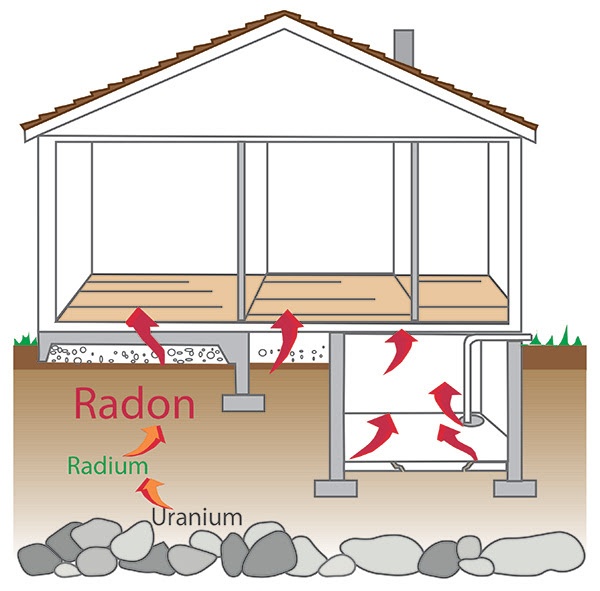
The amount of uranium 238 and its daughter product radium 226 are the key factors that determine indoor radon levels. Soil and rock permeability below the structure also influence indoor radon levels.
Radon High Risk Areas
In general the concentration of uranium 238 as well as the concentration of its long-lived daughter product radium 226 (half-life of 1,590 years) in the soils and rocks underlying a structure determine the potential indoor radon risk. However, variations in the permeability of the underlying soil and rocks can also influence indoor radon levels on a small scale.
Regions with granite with high uranium and radium concentrations, some coal regions, as well as areas with phosphate and uranium ores, are the areas of highest radon risk. Detailed tabulations and maps of radon risk areas by geographical location have been compiled for North America and allow an assessment of local radon risk. Average radon concentrations by county in the U.S. have been tabulated.
Perspective
While the U.S. EPA action level for radon remediation is 4 pCi/L, there is no safe limit for radon exposure. The U.S. EPA recommends that remediation be considered for any home with radon levels above 2 pCi/L, and the World Health Organization’s reference level is 2.7 pCi/L. Simply put, the higher the radon levels the higher the risk.
In some areas of the U.S. there are a significant number of homes with radon levels well above the EPA action level. On average, nationally 1 in 6 homes has indoor radon levels above 2 pCi/L and 1 in 15 has radon levels above 4 pCi/L. Radon remediation of existing homes and consideration for radon exposure in the design of new homes will continue well into the future with both indirect and direct ramifications for hearth and other energy related products. (See charts below).
EPA Map of Radon Zones
Radon Risk by U.S. County
Radon Potential Map – Canada
Radon Risk by Zones
About the Author – Dr. James E. Houck has been involved in environmental research and the hearth industry for over 30 years. He currently is an independent consultant and can be reached at: jbchouck@comcast.net.
Source: Hearth and Home Magazine

